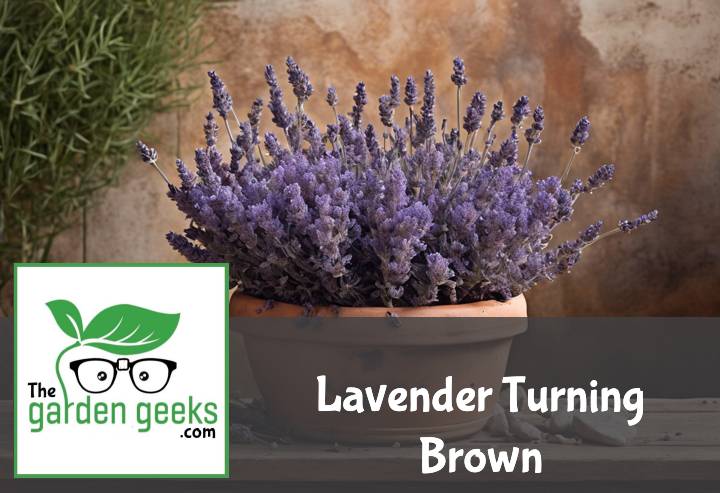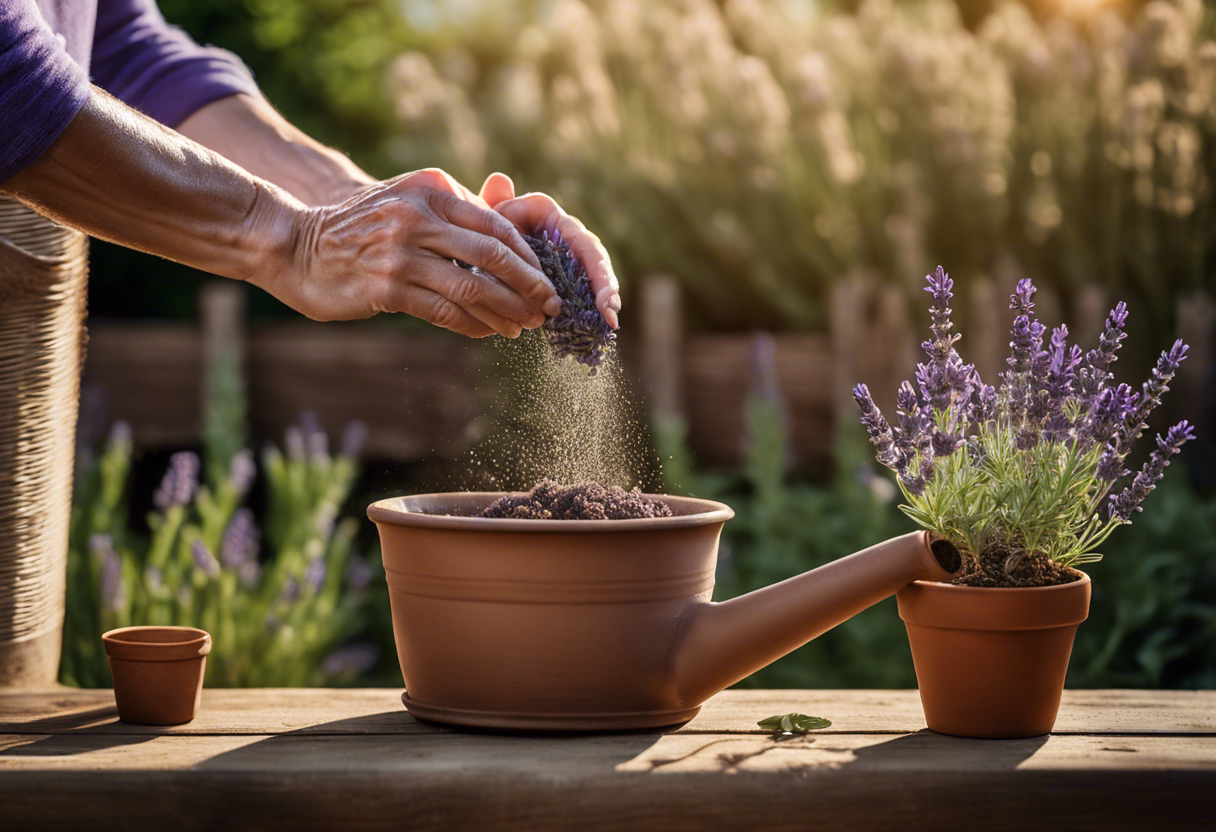Well, hello there fellow green thumb! Ever looked at your beloved lavender plant and thought, “Why is my Lavender Turning Brown?” Trust me; I’ve been there. It’s like watching a rom-com where you know the couple is meant to be together, but they just can’t get it right.
In this post, we’ll dive into the mystery of why our purple pals turn brown and explore four tried-and-true solutions. So buckle up, plant parent – we’re about to go on a botanical rescue mission! Keep reading about ‘Lavender Turning Brown? (4 Solutions that Actually work)’.
Key Takeaways
- Lavender plants may turn brown due to overwatering, poor soil conditions, extreme temperatures, or pests and diseases.
- To prevent overwatering, ensure the plant’s soil is well-draining and water only when the top inch of soil is dry.
- Improve soil conditions by adding organic matter or compost for better nutrient content.
- Protect lavender from extreme temperatures with mulch in winter and shade in summer.
- Regularly check for pests and diseases, using organic pesticides or fungicides if necessary.
Why is My Lavender Turning Brown?
So, you’ve noticed your lavender turning brown, huh? It’s a common issue that can leave any green thumb scratching their head. Understanding lavender plant care and the reasons behind those pesky brown lavender leaves is key to maintaining healthy plants.
Understanding Lavender Plant Health
A healthy lavender plant has vibrant purple flowers and lush green foliage. If you see any deviation from this, like wilting or browning, it’s a sign of an unhealthy lavender. Early detection of these issues can be a lifesaver for your plant.
Knowing the characteristics of healthy lavenders helps in identifying potential problems early on. So, keep an eye out for changes in color or texture. Remember, maintaining the health of your lavender isn’t just about watering and sunlight; it’s also about vigilance!
Common Causes of Browning in Lavender Plants
Now let’s get down to business: why is your lavender turning brown? Well, there are several culprits. Environmental factors such as extreme temperatures or improper watering can lead to browning.
Diseases are another common cause for brown lavenders. Root rot and fungal infections can wreak havoc on your lovely lavenders if not addressed promptly. But don’t worry! There are plenty of solutions for reviving brown lavenders.
Preventing browning involves understanding the causes and taking appropriate measures. Whether it’s adjusting your watering schedule or treating diseases early on, every step counts towards keeping your lavender plants happy and healthy!
Solution 1: Proper Watering Techniques
When it comes to lavender care, getting the watering techniques right is crucial. It’s like walking a tightrope, folks! Too much or too little water, and you might find your lavender turning brown.
Identifying Overwatering and Underwatering
Now let’s talk about how to spot if you’re giving your lavender a drink too often or not enough. If your plant looks more like a drowned rat than a flourishing flower, that’s a classic sign of overwatered lavender. The leaves may turn yellow and fall off – not exactly the look we’re going for!
On the other hand, underwatered lavender won’t be shy about letting you know either. The leaves will wilt, curl up and start turning brown. That’s right, they’ll throw a full-on tantrum! So keep an eye out for these plant health indicators to diagnose any watering issues.
How to Water Lavender Correctly
So how do you strike that perfect balance? Well, proper watering techniques for lavender aren’t rocket science. You want to give it a good soak but make sure the soil isn’t waterlogged.
The optimal watering schedule depends on the weather conditions – more frequent in hot weather and less so when it’s cooler. As for the best time to water lavender, aim for early morning or late evening when the sun isn’t at its peak.
Remember folks, with plants as with people, hydration is key! But just like you wouldn’t want to be drenched in water all day long (unless you’re Aquaman), neither does your lavender!
Solution 2: Appropriate Sunlight Exposure
When it comes to lavender care, getting the sunlight requirements right is a game-changer. It’s like giving your lavender a VIP ticket to good plant health. So, let’s dive into this light exposure business and see how we can make our indoor plants bask in glory.
The Importance of Sunlight for Lavenders
Sunlight for lavenders is like coffee for us humans – it kickstarts their day! It’s all about photosynthesis, folks. This process lets our sun-loving lavenders convert sunlight into energy, powering up their growth and keeping them healthy.
But wait, there’s more! Sunlight also plays a crucial role in lavender growth. It helps these beauties produce the oils that give them their signature scent. So, if you want your home smelling like a lavender field in Provence, don’t skimp on the sunlight!
Adjusting Your Lavender’s Sunlight Exposure
Alrighty then, let’s talk about adjusting light exposure. If your lavender turning brown is giving you sleepless nights, it might be crying out for some sunbathing time.
Signs of light stress in lavenders are pretty straightforward – too little light and they turn pale; too much and they start looking sunburnt. The trick lies in finding that sweet spot of optimal sunlight for lavenders.
If you’re growing your lavender indoors (kudos to you!), try moving it around until you find a spot where it gets just enough light but not too much. Remember, balance is key here – we want Goldilocks levels of sunlight: not too little, not too much, but just right!
Solution 3: Disease and Pest Control
When your lavender turns brown, it might be crying out for help against diseases and pests. A key part of lavender plant care involves keeping these unwelcome guests at bay. Let’s dive into the common culprits and how to show them the door.
Common Diseases and Pests Affecting Lavenders
Lavenders are pretty tough, but they’re not invincible. They can fall prey to a few diseases and pests that love to make their life miserable. Fungal diseases like root rot can turn your lavender brown if the soil is too wet.
On the pest side, we’ve got critters like spittlebugs and aphids. These guys suck the sap right out of your plants, leaving them looking sickly. Spotting these common lavender problems early can save your plant from a world of hurt.
Effective Methods for Disease and Pest Control
So, how do you keep these baddies away from your lavenders? Well, prevention is always better than cure. Good hygiene practices can go a long way in preventing lavender problems. Regularly clean up dead leaves around your plants to discourage fungal growth.
If pests have already moved in, don’t panic! There are plenty of pest control methods for lavenders out there. You could try spraying with water to knock off aphids or using insecticidal soap as a last resort.
For fungal diseases, improving drainage and avoiding overwatering can help keep them at bay. Remember, it’s all about creating an environment where your lavender can thrive while making life tough for diseases and pests.
Solution 4: Optimal Soil Conditions
When it comes to lavender turning brown, the culprit could be your soil. Lavenders are pretty picky about their dirt, you see. They need just the right conditions to thrive.
Ideal Soil Type for Lavenders
So, what’s the best soil for lavenders? Well, these plants love well-drained, sandy or gravelly soils. It’s all about that good drainage, folks! If water can’t escape, your lavender might as well be wearing cement shoes.
But it’s not just about avoiding wet feet. The right soil also helps with healthy lavender growth. A nice loose soil lets those roots spread out and get comfy. And a happy root system means a happy plant!
Improving Soil Conditions for Healthy Growth
Now, if your garden soil is more clay than sand, don’t despair! You can still make it work for your lavender plants. Start by adding some organic matter like compost or manure. This will help improve drainage and provide nutrients.
Next up, consider adding some grit or small stones to further enhance those draining capabilities. Remember, we’re aiming for that beachy feel here!
And finally, keep an eye on the pH level of your soil. Lavenders prefer slightly alkaline conditions so aim for a pH of around 6.5 to 7.5.
With these tips in mind, you’ll be on your way to nurturing healthy lavenders and saying goodbye to lavender turning brown!
To Wrap Up
In the wild world of gardening, having your Lavender Turning Brown can feel like a bad hair day that just won’t quit. But don’t fret! We’ve got you covered with four surefire solutions to bring back your lavender’s lustrous purple hue.
Remember, it’s all about proper watering, ideal sunlight, good soil drainage and keeping an eye out for pests. So go on, give these tips a try and watch your lavender flourish like a superstar on stage!





